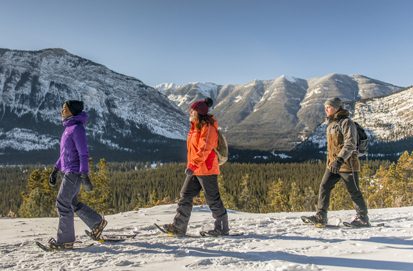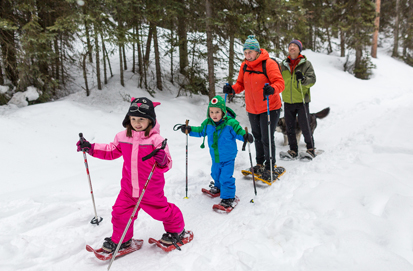
Snowshoeing
Banff National Park
Prime snowshoeing is available late December through early April and conditions are best after a recent snowfall. Be aware that avalanche season in the mountains extends from November to June. Designated winter trails follow portions of summer hiking trails but not all sign-posted destinations are safe for winter travel. Use the information below to choose a safe and fun destination. Strap on a pair of snowshoes and enjoy one of many snowshoeing trails.
Winter Safety
Safety is your responsibility. There are always hazards associated with outdoor recreation. Even short trips from the town of Banff can have serious consequences.
- Ask for advice at a Parks Canada Visitor Centre for help with trip planning.
- Check current trail conditions, warnings and closures.
- When trails are icy, hiking poles can make snowshoeing much more safe and enjoyable.
- Study descriptions and maps before heading out. Always choose a trail suitable for the least experienced member in your group.
- Tell somebody where you are going, when you will be back and who to call if you do not return.
- Expect that trail conditions and winter hazards may change throughout the day. Consult weather forecasts and be prepared for changing weather and emergencies.
- Winter hazards include avalanches, disorientation, thin ice, hypothermia and frostbite.
- From November to March, make sure your vehicle is winterized. Snow tires are mandatory on some roads. Consult the winter driving safety information and visit 511.alberta.ca for road reports.
- In case of EMERGENCY, call 911 or satellite phone: 403-762-4506. Cell phone coverage is not reliable throughout the national park.
Recommended Packing List
- Trail guide and map: guidebooks and topographic maps are available at the Banff and Lake Louise visitor centres, and retail outlets in Banff and Lake Louise.
- Full water bottle or thermos
- High energy food
- Bear spray
- Hiking poles
- First aid kit and repair kit
- Lightweight emergency blanket, candle and lighter or waterproof matches
- Headlamp or flashlight with spare batteries
- Toque or winter hat and gloves
- Sunscreen and sunglasses
- Hand and toe warmers
- Extra warm clothing in case of an emergency
- Cell phone or satellite emergency communication device
Visit parksmountainsafety.ca for additional information on winter packing.
Wildlife
Although bears are denning during the winter, they can awaken at any time for short periods. Cougars, wolves and other wildlife remain active throughout the year. If you see wildlife, do not approach; give them lots of space and observe from a distance with binoculars or a telephoto lens. If tracks are observed, do not follow them towards the animal.
Be alert, make noise, carry bear spray and know how to use it. Learn more about keeping yourself safe.
Report wildlife encounters and sightings of bears, cougars, wolves and coyotes: 403-762-1470.
Avalanche Risk

Avalanche season in the mountains extends from November to June, and even a short walk can take you into avalanche terrain. Trails on this page with a known hazard are identified with an avalanche symbol. When travelling beyond marked trails, or past an avalanche danger sign, assume you are in avalanche country – your group should be prepared with the appropriate knowledge, skills and equipment.
Check the current avalanche forecast at a Parks Canada visitor centre or avalanche.ca. Visit parksmountainsafety.ca for more information on backcountry travel and how to stay safe in the mountains.
Trail Etiquette
Trails are shared in the national park, which means you could see people fat biking while you are winter hiking, or people skiing while you are snowshoeing.
- The track-set portion of the trail is for classic skiing only. The flat, groomed lane is for other users.
- When climbing, please yield the right of way to descending skiers and fat bikers.
- When taking a break, step to the side, leaving room for others to pass.
- Leave no trace. Pack out everything you pack in.
- Read the trail descriptions as dogs are not allowed on some trails. Keep dogs on leash and under physical control at all times.
Where to go
- Date modified :

